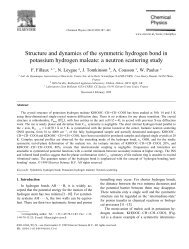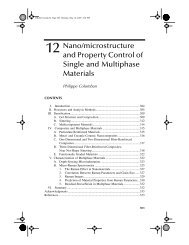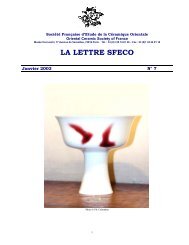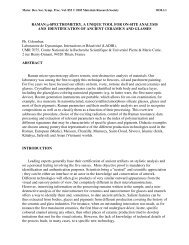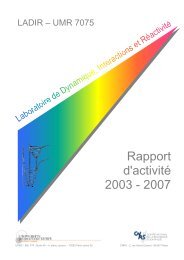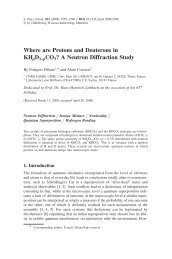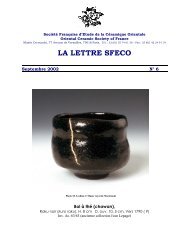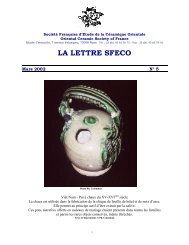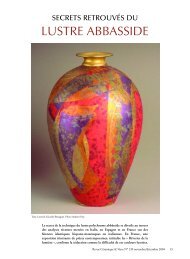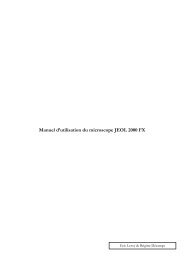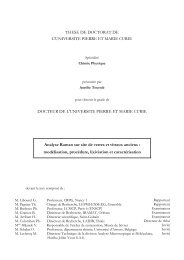Raman Spectroscopy of nanomaterials - institut de chimie et des ...
Raman Spectroscopy of nanomaterials - institut de chimie et des ...
Raman Spectroscopy of nanomaterials - institut de chimie et des ...
Create successful ePaper yourself
Turn your PDF publications into a flip-book with our unique Google optimized e-Paper software.
ARTICLE IN PRESS+ MODELG. Goua<strong>de</strong>c, Ph. Colomban / Progress in Crystal Growth and Characterization <strong>of</strong> Materialsxx (2007) 1e56ZIðnÞa d 3 ~kBZ½njCð~k 0 ;~kÞj 2nð~kÞŠ 2 þ 2 G0213ð12ÞEq. (12) mathematically expresses the <strong>Raman</strong> selection rule breaking induced by phonon confinement8 with a weighed exploration <strong>of</strong> the dispersion curves. Taking k BZe astheedge<strong>of</strong>BZ,q as thereduced wavevector (q ¼ k/k BZe ) and assuming isotropic mo<strong>de</strong> dispersion [180], Eq.(12) yields:IðnÞaZ q¼1q¼0dqe k2 BZe ðq q 0Þ 2 L 22a½n1nðqÞŠ 2 þ 2 G02ð13ÞThis is the equation to which most authors refer when using the PCM [179e186]. 9 For semiconductorQuantum Dots (QDs), NanoWires (NWs) or slabs, the PCM is easily adapted usingthe appropriate expressions for the d 3 ~k integration volume in Eq. (12) [189e193]. 10 Knowledge<strong>of</strong> the Vibrational Density <strong>of</strong> States (VDOS) is required for computing Eq. (13). It may be obtaine<strong>de</strong>ither from neutron scattering measurements, from data on parent structures or from abinitio calculations based on a rigid-mo<strong>de</strong>l structure [182,183,195e197]. The PCM, which doesnot apply to the acoustic mo<strong>de</strong>s because their energy is nil at BZc is very seldom used for theTO mo<strong>de</strong>s on account <strong>of</strong> their low dispersion [192,198]. It is almost exclusively applied to theLO mo<strong>de</strong>s. With LO wavenumbers usually being maximum at BZc, the integration in Eq. (13)introduces additional contributions on the low frequency si<strong>de</strong> <strong>of</strong> the single crystal mo<strong>de</strong> and theresulting peaks become asymm<strong>et</strong>ric. Peak adjustment is not always mandatory once phononconfinement has been invoked. In first approximation, the peak shift is in<strong>de</strong>ed proportionalto the inverse <strong>of</strong> the grain size [187,199]. The overall half-width at half-height also is, proportionalto the inverse <strong>of</strong> the grain size, as was reported for nanocrystalline CeO 2 [196,197] (seeFig. 6) or boron nitri<strong>de</strong> [187] and can be verified with data on Ge [184].In the paper introducing the PCM, Richter <strong>et</strong> al. [179] assumed a ¼ 2. Campbell and Fauch<strong>et</strong>[193] later tested several forms for the weighing function introduced in Eq. (9). They came to8 As a consequence <strong>of</strong> Heisenberg’s principle, the uncertainty Dk ¼ Dp/Z on the wavevector must remain above orequal to (2L) 1 .9 Based on the triple hypothesis that mo<strong>de</strong>s from different crystallites are uncorrelated, that lif<strong>et</strong>imes can be simulatedwith a Lorentzian broa<strong>de</strong>ning (G 0 ) and that susceptibility variations (Dc) are proportional to the normal vibration coordinates,Nemanich <strong>et</strong> al. [187] predicted the <strong>Raman</strong> intensity on probing <strong>of</strong> N orthorhombic crystallites to be:IðnÞaSð~k 0 ; nÞ¼N n B ðnÞþ1V X 1 C ~k; nc 2 V 2 j ð~kÞ jFð~k ~k 0 Þj 2 G 0 =4p n~k;jn nj ð~kÞ 2 ðN3Þþ G 2 0=4In this equation, S is the Fourier transform <strong>of</strong> polarisability variations associated with <strong>Raman</strong> scattering, ðn B ðnÞþ1Þ isthe Bose population factor ðn B ðnÞ ¼1=ðe hn=kT 1ÞÞ, C is the <strong>Raman</strong> coupling coefficient for branch j and jF(k k 0 )j 2 isthe uncertainty on the wavevector induced by phonon confinement [187,188]. This approach is entirely equivalent to thePCM if the F function is assumed to be Gaussian and the occupation term is neglected (this simplification is justifiedonly when a single band is mo<strong>de</strong>lled).10 Note that the PCM failed to predict the <strong>Raman</strong> shift in silicon spherical or columnar nanocrystals. Zi <strong>et</strong> al. [194]showed with a Bond Polarisability Mo<strong>de</strong>lling that it could rather be predicted using the following expression: a gn vib ¼ n bulk AðN4ÞLIn Eq. (N4), a is the lattice constant whereas A and g fully characterize the nanocrystal geom<strong>et</strong>ry.Please cite this article in press as: G. Goua<strong>de</strong>c, Ph. Colomban, Prog. Cryst. Growth Charact. Mater. (2007),doi:10.1016/j.pcrysgrow.2007.01.001



